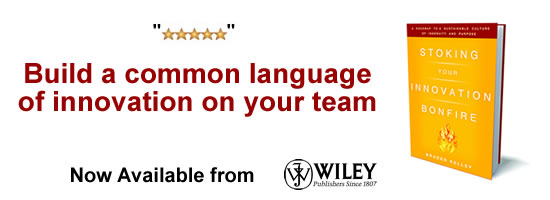How Innovation Really Happens
 When Alexander Fleming, a brilliant but sometimes careless scientist, returned to his lab after a summer holiday in 1928, he found his work ruined. A bacteria culture he had been growing was contaminated by fungus and, as it grew, it killed all the colonies it touched.
When Alexander Fleming, a brilliant but sometimes careless scientist, returned to his lab after a summer holiday in 1928, he found his work ruined. A bacteria culture he had been growing was contaminated by fungus and, as it grew, it killed all the colonies it touched.
Most people would have simply started over, but Fleming switched his focus from the bacteria to the fungus itself. First, identified the mold and the bacteria-killing substance, which he called “penicillin,†then he tested it on other bacteria cultures. Seemingly in a single stroke, Fleming had created the new field of antibiotics.
That’s how most people see innovation. A flash of brilliance and Eureka!, a new world is born. The truth is far messier. In fact, it wasn’t until 1943—nearly two decades later—that penicillin came into widespread use and only then because it was accelerated by the war effort. We need to discard old myths and deal with innovation as it really happens.
The Eureka! Myth
To put Fleming’s discovery in context, it’s helpful to look at the curious case of Ignaz Semmelweis, who pioneered the practice of hand washing in maternity wards, which virtually eliminated the scourge of childbed fever in the hospitals he presided over. Yet Semmelweis gained neither fame nor fortune, but rather the scorn of his colleagues.
The problem was that in the 1850’s Semmelweis’s ideas about hand washing conflicted with the prevailing miasma theory of the day. It was widely thought at the time that “bad airs†and an imbalance of humours, not bacteria, caused disease. So hand washing simply didn’t make any sense to the medical profession at the time.
It was only after Semmelweis’s death in any insane asylum in 1865 (ironically of an infection he caught there), that Louis Pasteur, Joseph Lister and Robert Koch brought the germ theory of disease into wide acceptance. In fact, Fleming’s work can be seen as a direct consequence of those earlier pioneers who established that bacteria causes disease.
So Fleming’s discovery was far from an isolated event. He knew from earlier scientists that bacteria were important and that’s why he recognized the significance of the bacteria-killing mold. If he had discovered the same thing 70 years earlier, he would have most probably met a similar fate to Semmelweis.
Engineering a Solution
Fleming was a gifted biologist, but a poor communicator and when he published his results in 1929, few took notice. He was also not a chemist and so was unable to study the molecule in any detail. So instead of changing the world, the world’s first antibiotic remained buried as an obscure finding in a scientific journal.
It wasn’t until 1935, a decade later, that Howard Florey and Ernst Chain, discovered Fleming’s paper, immediately understood its importance and developed a method to produce penicillin in quantity. They first began experimenting in mice, then humans and saw incredible results. Clearly, this new miracle drug had the potential to transform medicine.
Yet still, to make an impact, penicillin had to be produced in massive quantities, something that was far out of the reach of two research chemists. Florey reached out to the Rockefeller Foundation which provided further funding for research into new fermentation methods so that the drug could be mass produced.
By 1943, with World War II raging, the War Production Board enlisted 21 companies to produce supplies for the war effort, saving countless lives and ushering in the new age of antibiotics. Fleming, Florey and Chain received the Nobel Prize for Medicine in 1945.
Transforming Business Models
Penicillin, like so many other important innovations like the Internet and GPS, benefitted greatly from government support. Most entrepreneurs, however, have to forge their own path and it’s not always clear where the opportunity lies. That was exactly the problem that Chester Carlson had to overcome.
Self taught and brilliant, Carlson worked for years tinkering with his invention even while holding down a day job and going to law school at night. Â When his wife got tired of the explosions he made mixing chemicals in the kitchen, he moved his work to a second floor room in a house his mother-in-law owned.
After working on it for over a decade, he finally teamed up with the Haloid corporation, which helped him refine his product, but it still cost nearly ten times more than competitive machines. They tried to interest the great companies of the day—Kodak, IBM and GE—but all demurred.  There just didn’t seem to be a value proposition that would justify the cost.
Then Joe Wilson, the President of Haloid, had a billion dollar idea.  Instead of selling their machines, why don’t they lease them?  With this new business model, Carlson’s innovation took off and the company soon changed its name to the Xerox Corporation, which dominated the copier industry for decades.
Innovation is Never a Single Event
Look at any significant innovation and the myth of the lone genius and the “eureka moment†breaks down. A big idea is never enough, but needs to be developed into a viable solution and then adopted widely enough to make an impact. Innovation is never a singular event, but a process of discovering insights, engineering solutions and transforming fields and industries.
So while we sometimes like to believe that some people are innovators and others are not, the truth is that everyone has a potential role to play: scientists and engineers, marketers and accountants, salespeople and production specialists. That’s why we need to treat collaboration as the ultimate competitive advantage, especially today, when the problems we need to solve are so much more complex than in the past.
And that means we need to radically rethink how we approach innovation. First, as the authors of Collective Genius point out, we need to create a culture that inspires teamwork rather than just individual accomplishment. Great innovation happens when a diverse set of skills are integrated to effectively solve problems.
Second, need to rethink organizations themselves. In recent years, we’ve seen a new breed of innovators, such as the Institute for Applied Cancer Science at MD Anderson, the Joint Center for Energy Storage Research at Argonne National Laboratory, and the National Network for Manufacturing Innovation, that bring together government, academic institutions, and the private sector to solve our toughest problems.
Truly breakthrough innovations are never a single event, nor are they achieved by one person, or even within a single organization. Rather, they happen when ideas combine to solve important problems.
An earlier version of this article first appeared in Harvard Business Review
Wait! Before you go…
Choose how you want the latest innovation content delivered to you:
- Daily — RSS Feed — Email — Twitter — Facebook — Linkedin Today
- Weekly — Email Newsletter — Free Magazine — Linkedin Group
 Greg Satell is a popular speaker and consultant. His first book, Mapping Innovation: A Playbook for Navigating a Disruptive Age, is coming out in 2017. Follow his blog at Digital Tonto or on Twitter @Digital Tonto.
Greg Satell is a popular speaker and consultant. His first book, Mapping Innovation: A Playbook for Navigating a Disruptive Age, is coming out in 2017. Follow his blog at Digital Tonto or on Twitter @Digital Tonto.
NEVER MISS ANOTHER NEWSLETTER!
LATEST BLOGS
Three things you didn’t know about credit cards
Photo by Ales Nesetril on Unsplash Many of us use credit cards regularly. From using them for everyday purchases to…
Read MoreFive CV skills of a business-minded individual
Photo by Scott Graham on Unsplash The skills listed on a CV help employers quickly understand your suitability for a…
Read More


